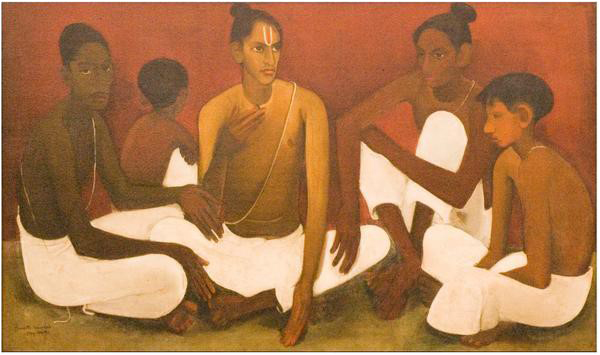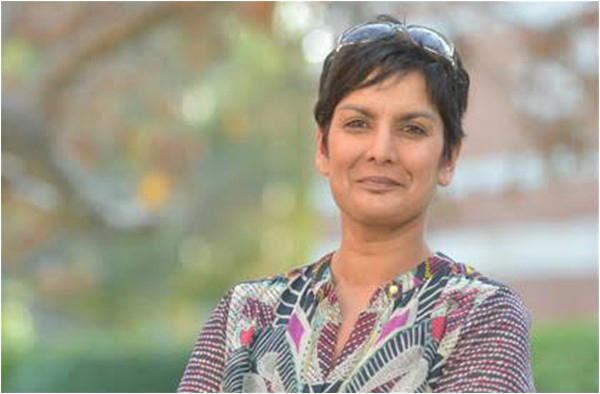How Amrita Sher-Gil brought a modernist aesthetic to the Subcontinent
By Ammara Ahmad
The Friday Times : 18 May 2018
Saloni Mathur, Art History professor at UCLA, talks to Ammara Ahmad about Amrita Sher-Gil, her relationship to Lahore and “proto-feminism”

“Europe belongs to Picasso, Matisse, and many others. India belongs only to me.”
(Amrita Sher-Gil)
Ammara Ahmad: Why a lecture on Amrita Sher-Gil at the Lahore Biennale?
Saloni Mathur: Because she is probably the most significant artist of the early twentieth century in pre-Partition South Asia. She is the one figure who has the largest body of scholarship about her. South Asian art history really has very few figures like that. Sher-Gil is a charismatic beginning of modernism in the Subcontinent. That was one issue and her relationship to Lahore, in particular, was why I wanted to bring her back here and really look at the legacy and think about her – in particular due to her relationship to Lahore.
AA: Did you see her house and her paintings in the Lahore museum today?
SM: I didn’t see the house itself but I saw it on Google Earth. And being here and thinking about Sher-Gil made it very clear to me as to the kind of network that she inhabited in the 1930s here – at the birth of the modernist movement: the intelligentsia, arts, her relationship to the Lahore museum (all pre-Partition) and what’s powerful is that she arrived at the top of her career in South Asia and was ready to really settle here and evolve her painting practice. Her story lasted only four months. She dies at the age of 29.

Amrita Sher-Gil – ‘Three girls’ – 1935
AA: Can you repeat that quote by Sher-Gil from the lecture comparing herself to the Europeans?
SM: She said something like “Europe belongs to Picasso, Matisse, and many others. India belongs only to me.” Meaning that modernism had been forged there – so it’s saturated. There is no place for me in Europe and their art history but in India, the art history is yet to be written and that’s where my future lies.
AA: Was she accurate in this description of herself?
SM: Well, she really was a pioneering modern painter in the Subcontinent. But as you know, what was fascinating about her is to take her European training and her European background and self-consciously to carve out a future career in India. And in the six to seven years that she lived, I think she was successful. She painted about a hundred paintings. Quite an uneven body of work, some better than many of the really accomplished works that she has become famous for. I think she made that maneuver – I use “modernist maneuver” as the title of my talk. I think it was a maneuver of one tradition to bear on another, carving an original modernist aesthetic for the Subcontinent.
AA: How did she bring India to herself?
SM: Yes, it is fascinating to know her own biography. She was born in Europe, lived there for the first eight years. Then eight years, until the age of sixteen, she lived in India – mostly in UP and Shimla. And then the whole family returned for her painting education in Paris. Then she trained as a painter and it was the 1930s in Europe, prior to the Second World War. Her mother was a Hungarian Jew. So I think they were forced to leave Europe actually, because of the conditions there. Then, of course, she showed in 1937 in Lahore at Falletti’s Hotel and then had wanted to settle here and be based here. I think it is fascinating because she presents the possibility of a future that was never realised. She had a real future and it was cut short.
AA: How does being an artist play in Amrita Sher-Gil’s dressing?
SM: In Amrita, it is inseparable. She was firstly very beautiful and charismatic – quite glamorous and very self-conscious about her presentation. In India she donned saris. She was a young person in her twenties who was aware of role switching and embracing what’s around her. I think she was constantly seeking a persona as an artist, as a young woman, a pioneering modernist and that is always in her self-presentation. And we know that now from the body of photographs of her.
“Sher-Gil was, kind of, India’s Frida Kahlo. In a sense they were contemporaries: they never met, but they were both really charismatic, self-conscious and powerful women at the beginnings of third-world modernism. And self-portraits are repeatedly part of how they do that. And of course, the similarity is that their lives were marked by tragedy”
AA: Much like Frida Kahlo?
SM: I think your mention of Kahlo is very astute because another writer on Sher-Gil has pointed out that Sher-Gil was kind of India’s Frida Kahlo. In a sense they were contemporaries: they never met, but they were both really charismatic, self-conscious and powerful women at the beginnings of third-world modernism. And you were right that self-portraits are repeatedly part of how they do that. And of course, the similarity is that their lives were marked by tragedy. Geeta Kapoor has described them as “proto-feminists”, meaning they are at the beginning of what by the end of the century would be a strong feminist engagement. They represent early instances of very strong women at the beginning of modernism.
‘Brahmacharis’ – Amrita Sher-Gil
AA: Where were you born, raised and how did this interest in art develop?
SM: I was born in India but my family went to Canada when I was young. I was born in Bihar but my family is all in UP – Delhi, and Lukhnow. And they came to Canada when I was five years old. I was raised in Canada but I revisited India in the 1970s. I did my training in Canada and then I did my Ph.D. in New York. My relationship with South Asia is very long and complex as a young person in the diaspora. We would always revisit family in Delhi and Agra. And then I happen to marry a Pakistani. He is from Karachi. He is a scholar as well. He is, among other things, a scholar of Urdu literature. My in-laws are in Karachi and I come regularly. So I have a relationship to both sides. We have a son who is now fourteen. It’s a diaspora relationship. Maybe that’s one of the reasons Sher-Gil speaks to me – because she is similarly formed (though 75-80 years ago), through these migrating conditions, circulating through the Subcontinent.
AA: Are you an artist?
SM: Unfortunately, I am not. Once you realise you have no talent as an artist you turn to the study of it. Art history was a way to stay close to the arts. I love writing and probably like you, I am a writer. And art is a difficult thing to write about. Art is elusive, hard to interpret – it is not clear whether one interpretation is correct. But I enjoy writing about art because of the challenges it represents.

‘Sumair’ – Amrita Sher-Gil – 1936
“This is surely one of the most exciting aspects of new directions of contemporary art in South Asia: the way in which it has helped transcend some of the logic of nation-states and their rigid boundaries”
AA: What is your experience as a migrant? Was it difficult despite you going there as a child?
SM: I think my experience as a migrant is a globally shared experience now, because there are so many of us in the world and almost everyone has family abroad. I think it is now a global situation, unlike in Sher-Gil’s time. She got isolated. It means I have multiple homes and families in different parts of the world. And I have lived all my life in the West but really it has been enhanced by this very intimate relationship to South Asian art, India, and Pakistan – to discourses around art.
AA: Is the experience different if you are a migrant and an artist?
SM: I think the universal questions rise – those of belonging to history, to a place, the role of belonging in one’s identity, belonging and unbelonging. Sometimes there is a difficult and fraught relationship of dis-identification, tensions of belonging and unbelonging.
AA: How has the experience of being in the midst of the immigrant population of California been after the Trump’s arrival?
SM: It’s been very profound. Because what has happened with Trump is that the discourses have been very reactionary and unaccepting of difference. I would say xenophobic and even white supremacist. And in the classrooms, in any humanities classrooms, we are ultimately talking about culture. And I believe it is impossible to teach these ideas in a vacuum because they are being played out in very real ways. And so, progressive thinking, the shared experiences of a place, different pasts, languages, and cultures – all these are under threat. You cannot take them for granted anymore.
AA: Is it possible to make a comparison of the artwork coming from India and Pakistan?
SM: Yes, it is possible to draw comparisons between the artwork coming from India and Pakistan. I believe that this is increasingly a shared cultural arena, made possible by artist networks, cross-border exchange, international residencies, shared discourses about art and the experience of increased travel and mobility in general. This is surely one of the most exciting aspects of new directions of contemporary art in South Asia: the way in which it has helped transcend some of the logic of nation-states and their rigid boundaries.

Saloni Mathur
AA: How was your experience in the Lahore Museum?
SM: I had a terrific time at the Lahore Museum. It was my third visit, and each visit only deepens my understanding of aesthetic objects and their relationships to culture and history. The collections are exquisite, and allowing contemporary artists to engage with this historic space through site-specific installations in conjunction with the Biennale energised the museum and gave it a new life. The best way to display archival material, in my opinion, is to present it in a way that invigorates our relation to both the past and the present.
AA: In one of your lectures you use the phrase “most radical exhibition” for the archival material’s presentation. What does the phrase “radical exhibition” mean?
SM: If I used the phrase “radical exhibition,” I probably meant that it incorporated display strategies that were novel, innovative, unafraid or experimental – and ultimately, successful in engaging with people and art in new and imaginative ways.
The writer is based in Lahore. Her works can be found at www.ammaraahmad.com and she tweets as @ammarawrites